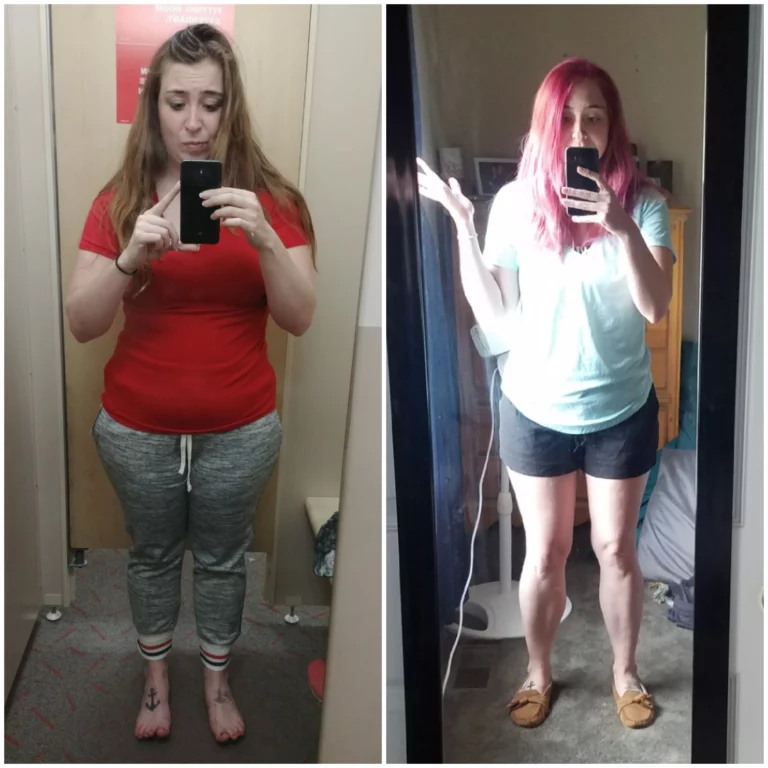How to Lose Weight With This Comprehensive Guide
Losing weight can be a challenging task, but it’s not impossible. With the right approach, anyone can achieve their weight loss goals. In this comprehensive guide, we will explore various effective ways to lose weight.
Kendra Lost 67 Pounds – Here’s How You Can Too!
Kendra had struggled with her weight for years, trying countless diets and exercise routines without much success. But after a health scare prompted her to take action, she committed to making lifestyle changes that would ultimately lead to a 67-pound weight loss.

So, how did Kendra do it? Here are the steps she took:
- Set a goal: Kendra set a specific goal of losing 2 pounds per week, giving her a timeline to work towards and something to measure her progress against.
- Made healthy food choices: Kendra started making healthier food choices, focusing on lean proteins, vegetables, and whole grains. She also cut out sugary drinks and snacks and limited her intake of processed foods.
- Exercised regularly: Kendra started exercising regularly, incorporating a mix of cardio and strength training into her routine. She found activities she enjoyed, such as cycling and yoga, and made them a regular part of her week.
- Got support: Kendra found support from friends and family, as well as online communities focused on weight loss and healthy living. She also sought out the help of a nutritionist and personal trainer to guide her journey.
- Celebrated milestones: Kendra celebrated each milestone along the way, whether it was losing a certain amount of weight or achieving a fitness goal. Celebrating her successes helped keep her motivated and on track.
Through hard work, dedication, and a commitment to making healthy lifestyle changes, Kendra was able to achieve her weight loss goals. By following these steps, anyone can set themselves up for success on their weight loss journey.
Healthy Weight Is Crucial
Maintaining a healthy weight is crucial for overall well-being. Being overweight or obese can increase the risk of developing several health problems, such as diabetes, heart disease, and high blood pressure. On the other hand, losing weight can have numerous benefits, including improved physical and mental health, increased energy levels, and reduced risk of chronic diseases.
Factors Contributing to Weight Gain:
Weight gain can be attributed to various factors, including unhealthy eating habits, lack of physical activity, hormonal imbalances, genetics, and stress. Overeating, consuming high-calorie foods and beverages, and sedentary lifestyles are some of the primary causes of weight gain. Hormonal imbalances, such as hypothyroidism, can also contribute to weight gain. Genetics and family history can play a role in determining body weight and composition. Moreover, stress can lead to emotional eating, which can result in weight gain over time.
Benefits of Losing Weight:
Losing weight can have significant benefits for both physical and mental health. Some of the benefits of weight loss include:
- Reduced risk of chronic diseases: Losing weight can lower the risk of developing chronic conditions such as type 2 diabetes, heart disease, and high blood pressure.
- Improved mental health: Weight loss can lead to improved mental health, including reduced stress and anxiety levels, better sleep, and improved self-esteem.
- Increased energy levels: Carrying excess weight can lead to fatigue and decreased energy levels. Losing weight can improve energy levels and increase physical activity.
- Better mobility: Losing weight can improve joint health and increase mobility, making it easier to perform daily activities.
- Improved overall quality of life: Losing weight can have a significant impact on overall well-being, leading to improved quality of life and increased longevity.
Maintaining a healthy weight is crucial for overall health and well-being. Understanding the factors that contribute to weight gain and the benefits of losing weight can help individuals make informed decisions about their health and adopt healthy lifestyle habits.
Setting Realistic Goals
When it comes to weight loss, setting achievable goals is crucial for success. Unrealistic goals can lead to disappointment and frustration, making it difficult to stick to a weight loss plan. Here are some tips for setting realistic weight loss goals:
Importance of Setting Achievable Goals:
Setting achievable goals is essential for maintaining motivation and momentum during the weight loss journey. When goals are achievable, individuals are more likely to stay committed to the process, leading to long-term success. Unrealistic goals, such as losing 10 pounds in a week, can be discouraging and may lead to giving up on the weight loss journey altogether. On the other hand, setting achievable goals can build confidence and lead to a sense of accomplishment, making it easier to continue making progress towards larger goals.
Tips for Setting Realistic Weight Loss Goals:
- Set specific goals: Instead of setting a vague goal, such as “losing weight,” set specific goals such as losing 1-2 pounds per week or fitting into a specific size of clothing.
- Consider your current lifestyle: When setting goals, it’s important to consider your current lifestyle and how much time and energy you can realistically commit to a weight loss plan. Setting goals that require too much time or effort can be overwhelming and lead to giving up.
- Make small changes: Instead of trying to overhaul your entire lifestyle at once, start with small changes, such as drinking more water or adding a few minutes of exercise to your daily routine.
- Track your progress: Keeping track of progress can help you stay motivated and adjust goals as needed. Consider using a food journal or fitness tracker to monitor progress.
- Celebrate milestones: Celebrating small successes along the way can help build motivation and make the weight loss journey more enjoyable.
Setting achievable goals is crucial for weight loss success. By setting specific, realistic goals and making small changes over time, individuals can build confidence and momentum towards larger goals. Tracking progress and celebrating milestones along the way can help maintain motivation and make the weight loss journey more enjoyable.
Creating a Caloric Deficit
A calorie deficit occurs when the number of calories consumed is less than the number of calories burned. This results in the body burning stored fat for energy, leading to weight loss. Here’s a closer look at the concept of calorie deficit and how to create one:
Understanding the Concept of Calorie Deficit:
The human body requires a certain number of calories to maintain its current weight. Consuming more calories than the body needs can lead to weight gain, while consuming fewer calories than the body needs leads to weight loss. A calorie deficit occurs when the number of calories burned exceeds the number of calories consumed.
Importance of Calorie Deficit for Weight Loss:
A calorie deficit is a fundamental concept in weight loss. To lose weight, the body must burn more calories than it consumes. Creating a calorie deficit is necessary to achieve weight loss goals. Without a calorie deficit, weight loss is unlikely to occur.
Ways to Create a Calorie Deficit:
- Reduce calorie intake: One of the most effective ways to create a calorie deficit is to reduce calorie intake. This can be achieved by making healthier food choices, reducing portion sizes, and cutting out high-calorie foods and beverages.
- Increase physical activity: Exercise can help create a calorie deficit by increasing the number of calories burned. Cardiovascular exercise, such as running or cycling, and resistance training, such as weightlifting, can both help burn calories and create a calorie deficit.
- Combination of diet and exercise: Combining healthy eating habits with regular exercise can create a larger calorie deficit, leading to faster weight loss.
- Tracking calories: Keeping track of calories consumed and burned can help create a calorie deficit by making it easier to monitor progress and make adjustments as needed.
Creating a calorie deficit is essential for weight loss. Understanding the concept of calorie deficit, its importance for weight loss, and ways to create a calorie deficit can help anyone achieve their weight loss goals. Reducing calorie intake, increasing physical activity, or a combination of both, can all create a calorie deficit and lead to successful weight loss.
Healthy Eating Habits
Healthy eating habits are an essential component of any successful weight loss journey. Here’s a closer look at why healthy eating habits are important for weight loss, types of diets for weight loss, and tips for healthy eating:
Importance of Healthy Eating Habits for Weight Loss:
Healthy eating habits are crucial for weight loss for several reasons. First, consuming fewer calories than the body needs creates a calorie deficit, leading to weight loss. Secondly, eating nutritious foods can help improve overall health and well-being, making it easier to stick to a weight loss plan. Finally, healthy eating habits can help prevent chronic diseases such as type 2 diabetes, heart disease, and high blood pressure.
Types of Diets for Weight Loss:
- Low-carb diet: A low-carb diet focuses on limiting carbohydrates and increasing protein and fat intake. This type of diet can be effective for weight loss, as it can lead to a reduction in appetite and increased fat burning.
- Mediterranean diet: A Mediterranean diet focuses on consuming whole, nutrient-dense foods such as fruits, vegetables, whole grains, and healthy fats. This type of diet has been shown to be effective for weight loss and can also help reduce the risk of chronic diseases.
- Plant-based diet: A plant-based diet focuses on consuming foods from plant sources, such as fruits, vegetables, whole grains, and legumes. This type of diet can be effective for weight loss and has been shown to improve overall health.
Tips for Healthy Eating:
- Focus on nutrient-dense foods: Consuming foods that are high in nutrients and low in calories can help promote weight loss and overall health. Foods such as fruits, vegetables, whole grains, and lean proteins are nutrient-dense and can help keep you feeling full and satisfied.
- Practice portion control: Eating appropriate portion sizes can help prevent overeating and promote weight loss. Using smaller plates, measuring out portions, and listening to your body’s hunger cues can all help with portion control.
- Limit processed foods: Processed foods are often high in calories, sodium, and unhealthy fats, and can contribute to weight gain. Limiting or avoiding processed foods can help promote weight loss and overall health.
- Drink plenty of water: Drinking water can help keep you hydrated and promote feelings of fullness, leading to decreased calorie intake.
Healthy eating habits are essential for weight loss and overall health. Choosing a healthy diet plan, such as a low-carb or Mediterranean diet, and following tips such as focusing on nutrient-dense foods, practicing portion control, limiting processed foods, and drinking plenty of water can all promote weight loss and improved health.
The Importance of Protein
Protein is a crucial macronutrient that plays many important roles in the body, including building and repairing tissues, supporting immune function, and maintaining muscle mass. Protein can also be a valuable tool for weight loss. Here’s a closer look at the benefits of protein for weight loss and foods high in protein:
Benefits of Protein for Weight Loss:
- Increased satiety: Protein is a filling nutrient that can help increase feelings of fullness and reduce overall calorie intake. Eating protein-rich foods can help reduce cravings and prevent overeating.
- Increased calorie burning: Protein has a high thermic effect, meaning that the body burns more calories digesting protein than it does digesting carbohydrates or fats. This increased calorie burning can help create a calorie deficit and lead to weight loss.
- Muscle maintenance: When following a weight loss plan, it’s important to maintain muscle mass. Consuming adequate protein can help preserve muscle mass while losing fat.
Foods High in Protein:
- Lean meats: Lean meats such as chicken, turkey, fish, and lean cuts of beef and pork are excellent sources of protein.
- Eggs: Eggs are a versatile and nutrient-dense source of protein, with approximately 6 grams of protein per egg.
- Legumes: Legumes such as beans, lentils, and chickpeas are rich in both protein and fiber, making them an excellent choice for weight loss.
- Dairy: Dairy products such as Greek yogurt and cottage cheese are high in protein and can help increase feelings of fullness.
- Nuts and seeds: Nuts and seeds such as almonds, peanuts, and chia seeds are high in protein, healthy fats, and fiber.
Consuming adequate protein is important for overall health and can be a valuable tool for weight loss. Incorporating protein-rich foods such as lean meats, eggs, legumes, dairy, and nuts and seeds into the diet can help increase feelings of fullness, burn more calories, and preserve muscle mass while losing weight.
The Role of Carbohydrates
Carbohydrates are one of the three macronutrients, along with protein and fat. They are an important source of energy for the body and play a crucial role in various bodily functions. Here’s a closer look at the types of carbohydrates and their role in weight loss:
Types of Carbohydrates:
There are two main types of carbohydrates: simple and complex.
- Simple carbohydrates: Simple carbohydrates, also known as “simple sugars,” are found in foods such as fruit, milk, and candy. They are quickly broken down and absorbed by the body, leading to a rapid rise in blood sugar levels.
- Complex carbohydrates: Complex carbohydrates are found in foods such as whole grains, beans, and vegetables. They take longer to break down and are absorbed more slowly by the body, leading to a slower and more sustained release of energy.
Carbohydrates and Weight Loss:
Carbohydrates can be an important tool for weight loss, but it’s important to choose the right types and consume them in moderation. Here are some tips for incorporating carbohydrates into a weight loss plan:
- Choose complex carbohydrates: Complex carbohydrates are a healthier choice than simple carbohydrates because they are absorbed more slowly by the body and provide a sustained source of energy.
- Limit added sugars: Foods and beverages that are high in added sugars, such as soda and candy, should be limited or avoided altogether as they can contribute to weight gain.
- Watch portion sizes: While carbohydrates are an important source of energy, it’s important to watch portion sizes and consume them in moderation. Eating too many carbohydrates, even the healthy ones, can lead to weight gain.
- Combine with protein and healthy fats: Combining carbohydrates with protein and healthy fats can help increase feelings of fullness and reduce overall calorie intake, leading to weight loss.
Carbohydrates are an important source of energy and play a crucial role in bodily functions. Incorporating complex carbohydrates into a weight loss plan and consuming them in moderation, while limiting added sugars, can help promote weight loss and overall health. Combining carbohydrates with protein and healthy fats can also help increase feelings of fullness and reduce calorie intake.
The Impact of Fats
Fats are an important macronutrient that play many important roles in the body, including providing energy, protecting vital organs, and aiding in nutrient absorption. Here’s a closer look at the types of fats and their role in weight loss:
Types of Fats:
There are four main types of fats: saturated, trans, monounsaturated, and polyunsaturated.
- Saturated fats: Saturated fats are found in animal products such as meat and dairy, as well as in some plant sources such as coconut and palm oil. They are typically solid at room temperature and can contribute to elevated cholesterol levels.
- Trans fats: Trans fats are found in processed foods such as baked goods, fried foods, and snacks. They are created by adding hydrogen to liquid oils, making them solid at room temperature. Trans fats can increase the risk of heart disease and should be avoided.
- Monounsaturated fats: Monounsaturated fats are found in foods such as olive oil, nuts, and avocados. They can help reduce cholesterol levels and improve heart health.
- Polyunsaturated fats: Polyunsaturated fats are found in foods such as fatty fish, flaxseed, and sunflower seeds. They are important for brain function and can help reduce inflammation in the body.
The Role of Fats in Weight Loss:
Fats can play a role in weight loss, but it’s important to choose the right types and consume them in moderation. Here are some tips for incorporating fats into a weight loss plan:
- Choose healthy fats: Consuming healthy fats, such as monounsaturated and polyunsaturated fats, can help improve heart health and aid in weight loss. Foods such as nuts, seeds, and fatty fish are good sources of healthy fats.
- Watch portion sizes: Fats are high in calories, so it’s important to watch portion sizes and consume them in moderation.
- Replace unhealthy fats: Replacing unhealthy fats, such as trans and saturated fats, with healthy fats can aid in weight loss and improve overall health.
- Combine with protein and carbohydrates: Combining healthy fats with protein and carbohydrates can help increase feelings of fullness and reduce overall calorie intake, leading to weight loss.
Fats are an important macronutrient that play many important roles in the body. Consuming healthy fats in moderation can aid in weight loss and improve overall health. It’s important to choose the right types of fats and watch portion sizes when incorporating fats into a weight loss plan.
Fiber and Weight Loss
Fiber is an important nutrient that is often overlooked but plays a crucial role in weight loss. Here’s a closer look at the benefits of fiber and high fiber foods:
Benefits of Fiber:
- Increased satiety: Fiber is filling and can help increase feelings of fullness, leading to decreased calorie intake.
- Improved digestion: Fiber can help regulate digestion and prevent constipation, which can improve overall health and well-being.
- Reduced calorie absorption: Fiber can bind to fat and carbohydrates in the digestive tract, preventing their absorption and leading to decreased calorie intake.
- Reduced inflammation: High fiber diets have been linked to reduced inflammation in the body, which can improve overall health and prevent chronic diseases.
High Fiber Foods:
- Fruits and vegetables: Fruits and vegetables are naturally high in fiber and can be an excellent addition to a weight loss plan. Berries, apples, bananas, broccoli, and spinach are all high in fiber.
- Whole grains: Whole grains such as oats, quinoa, and brown rice are high in fiber and can be a healthy choice for weight loss.
- Legumes: Legumes such as lentils, chickpeas, and black beans are high in fiber and can help increase feelings of fullness.
- Nuts and seeds: Nuts and seeds such as almonds, chia seeds, and flaxseeds are high in fiber and can be a healthy addition to any weight loss plan.
Consuming adequate fiber is important for weight loss and overall health. Incorporating high fiber foods such as fruits and vegetables, whole grains, legumes, and nuts and seeds into the diet can help increase feelings of fullness, decrease calorie intake, and improve digestion and overall health.
Regular Exercise
Exercise is an important component of any weight loss plan. Here’s a closer look at the importance of exercise for weight loss, types of exercise for weight loss, and tips for making exercise a habit:
Importance of Exercise for Weight Loss:
- Increased calorie burning: Exercise can help burn calories and create a calorie deficit, leading to weight loss.
- Improved metabolism: Regular exercise can help improve metabolism, leading to increased calorie burning even at rest.
- Reduced muscle loss: When losing weight, it’s important to maintain muscle mass. Exercise can help preserve muscle mass while losing fat.
- Improved overall health: Exercise can improve overall health and well-being, leading to improved mood, reduced stress, and a decreased risk of chronic diseases.
Types of Exercise for Weight Loss:
- Cardiovascular exercise: Cardiovascular exercise, such as running, cycling, or swimming, can help burn calories and improve heart health.
- Strength training: Strength training can help build muscle mass and increase metabolism, leading to increased calorie burning and weight loss.
- High-intensity interval training (HIIT): HIIT involves short bursts of intense exercise followed by periods of rest. This type of exercise can help burn calories and improve cardiovascular health.
Tips for Making Exercise a Habit:
- Start small: Begin with small, achievable goals and gradually increase the intensity and duration of exercise.
- Make it enjoyable: Choose exercises that you enjoy and find fun, such as dancing, hiking, or playing a sport.
- Find a workout buddy: Working out with a friend or family member can help provide accountability and make exercise more enjoyable.
- Schedule it in: Schedule exercise into your daily routine, just like you would any other appointment or task.
- Celebrate progress: Celebrate small successes along the way to keep motivation high and make exercise a habit.
Regular exercise is an important component of any weight loss plan. Incorporating cardiovascular exercise, strength training, and HIIT into a routine can help burn calories, increase metabolism, and improve overall health. Making exercise a habit by starting small, making it enjoyable, finding a workout buddy, scheduling it in, and celebrating progress can help ensure success in reaching weight loss goals.
Resistance Training
Resistance training, also known as strength training or weightlifting, involves using weights or resistance to build muscle and improve strength. Here’s a closer look at the benefits of resistance training and types of resistance training exercises:
Benefits of Resistance Training:
- Increased muscle mass: Resistance training can help build muscle mass, leading to increased metabolism and calorie burning.
- Improved bone health: Resistance training can help improve bone density, reducing the risk of osteoporosis.
- Improved strength: Resistance training can help improve overall strength and functional fitness, making daily activities easier and reducing the risk of injury.
- Improved body composition: Resistance training can help improve body composition by reducing body fat and increasing muscle mass.
Types of Resistance Training Exercises:
- Bodyweight exercises: Bodyweight exercises, such as push-ups, squats, and lunges, use the body’s own weight as resistance and can be done anywhere with no equipment.
- Free weights: Free weights, such as dumbbells and barbells, allow for a wide variety of exercises and can be used to target specific muscle groups.
- Resistance bands: Resistance bands are a portable and inexpensive way to add resistance to exercises and can be used to target specific muscle groups.
- Machines: Weight machines can provide a guided and controlled way to perform resistance training exercises and are often found in gyms.
Resistance training is an important component of any weight loss plan. Incorporating bodyweight exercises, free weights, resistance bands, or weight machines into a routine can help build muscle mass, improve bone health, and increase strength and overall fitness.
Cardiovascular Exercise
Cardiovascular exercise, also known as aerobic exercise, involves activities that increase heart rate and respiration, leading to improved cardiovascular health and increased calorie burning. Here’s a closer look at the benefits of cardio and types of cardio exercises:
Benefits of Cardio:
- Improved heart health: Cardiovascular exercise can help improve heart health by strengthening the heart muscle and reducing the risk of cardiovascular disease.
- Increased calorie burning: Cardiovascular exercise can help burn calories and create a calorie deficit, leading to weight loss.
- Improved lung function: Cardiovascular exercise can improve lung function and increase oxygen delivery to the body.
- Improved mental health: Cardiovascular exercise can improve mood, reduce stress, and improve overall mental health.
Types of Cardio Exercises:
- Running/jogging: Running and jogging are popular forms of cardio that can be done outdoors or on a treadmill.
- Cycling: Cycling, either outdoors or on a stationary bike, is a low-impact form of cardio that can be done alone or in a group.
- Swimming: Swimming is a full-body workout that can be a low-impact form of cardio for those with joint pain.
- Dancing: Dancing is a fun and social form of cardio that can be done alone or in a group.
- High-intensity interval training (HIIT): HIIT involves short bursts of intense exercise followed by periods of rest and can be done with any form of cardio exercise.
Cardiovascular exercise is an important component of any weight loss plan. Incorporating running, cycling, swimming, dancing, or HIIT into a routine can help improve heart health, increase calorie burning, and improve overall mental health.
HIIT (High-Intensity Interval Training)
HIIT, or high-intensity interval training, is a type of exercise that involves short bursts of intense exercise followed by periods of rest or low-intensity exercise. Here’s a closer look at the benefits of HIIT and some examples of HIIT exercises:
Benefits of HIIT:
- Increased calorie burning: HIIT can help burn calories and create a calorie deficit, leading to weight loss.
- Improved cardiovascular health: HIIT can help improve cardiovascular health by increasing heart rate and strengthening the heart muscle.
- Improved metabolic health: HIIT can improve metabolic health by improving insulin sensitivity and reducing blood sugar levels.
- Increased muscle tone: HIIT can help build muscle mass and improve muscle tone.
HIIT Exercises:
- Burpees: Burpees involve jumping, squatting, and push-ups, making them a full-body exercise that can be done anywhere.
- Sprint intervals: Sprint intervals involve short bursts of sprinting followed by periods of rest or low-intensity exercise.
- Jump rope: Jumping rope is a great way to get the heart rate up and can be done anywhere with minimal equipment.
- Tabata: Tabata involves 20 seconds of intense exercise followed by 10 seconds of rest, repeated for a total of four minutes.
- Plyometrics: Plyometrics involve explosive movements such as jumping or bounding and can help improve overall athleticism.
HIIT is a type of exercise that can be a great addition to a weight loss plan. Incorporating exercises such as burpees, sprint intervals, jump rope, Tabata, and plyometrics can help increase calorie burning, improve cardiovascular and metabolic health, and increase muscle tone.
Healthy Lifestyle Habits
Healthy lifestyle habits are an important component of any weight loss plan. Here’s a closer look at the importance of healthy lifestyle habits and some tips for living a healthy lifestyle:
Importance of Healthy Lifestyle Habits:
- Improved overall health: Healthy lifestyle habits can help improve overall health and well-being, reducing the risk of chronic diseases such as diabetes, heart disease, and cancer.
- Increased energy: Living a healthy lifestyle can help increase energy levels and improve overall productivity.
- Improved mental health: Healthy lifestyle habits can help reduce stress and anxiety, improving overall mental health.
- Sustainable weight loss: Healthy lifestyle habits can help facilitate sustainable weight loss and weight maintenance.
Tips for a Healthy Lifestyle:
- Eat a balanced diet: Consuming a balanced diet that includes plenty of fruits, vegetables, whole grains, lean protein, and healthy fats can help improve overall health and aid in weight loss.
- Stay hydrated: Drinking plenty of water throughout the day can help improve digestion, increase energy levels, and aid in weight loss.
- Exercise regularly: Incorporating regular exercise into a routine can help increase calorie burning, improve cardiovascular and metabolic health, and aid in weight loss.
- Get enough sleep: Getting enough sleep is important for overall health and well-being, as well as weight loss and weight maintenance.
- Manage stress: Managing stress through practices such as meditation, yoga, or deep breathing can help reduce cortisol levels and improve overall mental health.
- Limit alcohol consumption: Consuming excessive amounts of alcohol can lead to weight gain and other negative health effects, so it’s important to limit intake.
Healthy lifestyle habits are an important component of any weight loss plan. Eating a balanced diet, staying hydrated, exercising regularly, getting enough sleep, managing stress, and limiting alcohol consumption can help improve overall health and aid in weight loss and weight maintenance.
Sleep and Weight Loss
Sleep is an often-overlooked factor in weight loss, but it can have a significant impact on weight loss efforts. Here’s a closer look at the impact of sleep on weight loss and some tips for getting better sleep:
The Impact of Sleep on Weight Loss:
- Increased hunger: Lack of sleep can increase levels of the hormone ghrelin, which stimulates hunger and can lead to overeating.
- Decreased metabolism: Lack of sleep can decrease metabolism, leading to decreased calorie burning and weight gain.
- Increased cortisol levels: Lack of sleep can increase levels of the stress hormone cortisol, which can lead to increased belly fat and weight gain.
- Decreased willpower: Lack of sleep can decrease willpower and motivation, leading to decreased adherence to healthy lifestyle habits.
Tips for Better Sleep:
- Stick to a regular sleep schedule: Going to bed and waking up at the same time each day can help regulate the body’s internal clock and improve sleep.
- Create a relaxing bedtime routine: Engaging in relaxing activities such as reading or taking a warm bath can help signal to the body that it’s time for sleep.
- Avoid screens before bed: Exposure to blue light from screens such as phones, tablets, and computers can interfere with sleep.
- Create a comfortable sleep environment: Keeping the bedroom cool, dark, and quiet can help promote restful sleep.
- Limit caffeine and alcohol intake: Consuming caffeine or alcohol too close to bedtime can interfere with sleep.
- Get regular exercise: Regular exercise can help improve sleep quality and duration.
Sleep is an important factor in weight loss and weight maintenance. Lack of sleep can lead to increased hunger, decreased metabolism, increased cortisol levels, and decreased willpower, all of which can hinder weight loss efforts. Incorporating tips such as sticking to a regular sleep schedule, creating a relaxing bedtime routine, avoiding screens before bed, creating a comfortable sleep environment, limiting caffeine and alcohol intake, and getting regular exercise can help improve sleep quality and aid in weight loss efforts.
Stress Management and Weight Loss
Stress is a common factor in weight gain and can be a significant obstacle to weight loss. Here’s a closer look at the impact of stress on weight loss and some tips for managing stress:
The Impact of Stress on Weight Loss:
- Increased cortisol levels: Stress can lead to increased levels of the stress hormone cortisol, which can lead to increased belly fat and weight gain.
- Emotional eating: Stress can lead to emotional eating, or eating in response to emotions rather than hunger, which can lead to overeating and weight gain.
- Decreased motivation: Stress can decrease motivation and willpower, leading to decreased adherence to healthy lifestyle habits.
- Disrupted sleep: Stress can interfere with sleep, which can lead to increased hunger, decreased metabolism, and weight gain.
Tips for Stress Management:
- Exercise: Regular exercise can help reduce stress and improve mood.
- Mindfulness and meditation: Practices such as mindfulness and meditation can help reduce stress and improve overall mental health.
- Time management: Effective time management can help reduce stress and increase productivity.
- Social support: Seeking support from friends or family can help reduce stress and improve overall well-being.
- Relaxation techniques: Engaging in relaxation techniques such as deep breathing or taking a warm bath can help reduce stress and improve sleep.
- Counseling or therapy: Seeking professional help such as counseling or therapy can help manage stress and improve overall mental health.
Stress is an important factor in weight gain and can hinder weight loss efforts. Increased cortisol levels, emotional eating, decreased motivation, and disrupted sleep are all potential consequences of stress. Incorporating stress management techniques such as exercise, mindfulness and meditation, time management, social support, relaxation techniques, and counseling or therapy can help manage stress and improve overall well-being, leading to increased success in weight loss efforts.
Start Today How to Lose Weight A Comprehensive Guide
Losing weight can be a challenging but rewarding process that requires a combination of healthy eating habits, regular exercise, and a healthy lifestyle. By setting achievable goals, creating a calorie deficit, and adopting healthy habits such as getting enough sleep, managing stress, and staying hydrated, anyone can achieve their weight loss goals.
It’s important to remember that weight loss is not a one-size-fits-all approach, and what works for one person may not work for another. It’s important to stay patient, persistent, and flexible in your approach, and to seek support from friends, family, or Dr. Nancie and Dr. Alphonso if needed.
With dedication and hard work, anyone can achieve their weight loss goals and improve their overall health and well-being.
FAQs
- What’s the best way to lose weight?
The best way to lose weight is by creating a calorie deficit through a combination of healthy eating habits and regular exercise. This can include consuming a balanced diet that is low in processed foods and high in fruits, vegetables, whole grains, lean protein, and healthy fats, as well as incorporating regular exercise into a routine.
- Is it necessary to count calories for weight loss?
Counting calories can be a useful tool for weight loss, as it can help create a calorie deficit and ensure that individuals are consuming the appropriate number of calories for their weight loss goals. However, it’s not necessary for everyone to count calories, as long as they are following a balanced diet and monitoring portion sizes.
- How long does it take to see results from weight loss efforts?
The timeline for seeing results from weight loss efforts can vary depending on factors such as starting weight, weight loss goals, and adherence to healthy lifestyle habits. In general, it’s recommended to aim for a weight loss of 1-2 pounds per week, which can lead to significant results over time.
- Can weight loss be achieved without exercise?
Weight loss can be achieved without exercise through a combination of healthy eating habits and creating a calorie deficit. However, incorporating regular exercise into a weight loss plan can help increase calorie burning, improve overall health, and aid in weight loss and weight maintenance.
- What should I do if I hit a weight loss plateau?
If you hit a weight loss plateau, it’s important to reassess your weight loss plan and make adjustments as needed. This can include increasing exercise intensity, adjusting calorie intake, or changing up your exercise routine. It’s also important to stay patient and persistent, as weight loss plateaus are a common occurrence and can be overcome with time and effort.
What To Do Next…
For people who want to stop struggling with their weight

We Now Have FDA Approved Semaglutide Weight Loss in Sarasota and Bradenton Florida. Book a free consultation and find out about the semaglutide cost and semaglutide side effects. Semaglutide injection are available after your free consultation.






